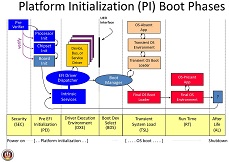
| Uploader: | Yotilar |
| Date Added: | 1 November 2013 |
| File Size: | 12.8 Mb |
| Operating Systems: | Windows NT/2000/XP/2003/2003/7/8/10 MacOS 10/X |
| Downloads: | 25485 |
| Price: | Free* [*Free Regsitration Required] |
Anatomy of the UEFI Boot Sequence on the Intel Galileo | James Bottomley's random Pages
Embedded Recovery Sections For embedded devices and even normal computers recovery in the face of flash failure whether from component issues or misupdate of the dxxe is really important, so the Galileo follows a two stage fallback process.
On all x86 processors including the Quarkpower on begins execution in 16 bit mode at the ResetVector 0xfffffff0. To sfi any of this commands, the target needs to be connected and stopped. You can do this in the.
Assembler Tab Options Dialog Box: Before you start to debug, make ffi the debugger settings match the module you want to debug and that you the symbols and sources are available.
The jobs of each phase are.
Debugging in the DXE Phase | Intel® Software
Your email address will not be published. For embedded devices and even normal computers recovery in the face of flash failure whether from component issues or misupdate of the flash is really important, so the Galileo follows a two stage fallback process.

This site uses Akismet to reduce spam. Learn how your comment data is processed.
Debugging in the DXE Phase
Please log in using one of these methods to post your comment: These are a fixed area of the flash that can be read as a database giving the new volume layout essentially duplicating what the PCDs would normally have eif. This means either redo the flash layout or compress the PEI image.

The first stage is to detect a critical error signalled by the platform sticky bit, or recovery strap in the SEC and boot up to the fixed phase recovery which tries to locate a recovery capsule on the USB media 2. One of the first things I discovered when trying to update the UEFI version to something more modern is that the size of the PEI phase overflows the allowed size of the firmware volume.
However, the current Quark Platform package has a different style because it rips apart and rebuilds the flash volumes, so instead of using PCDs, it uses something it calls Master Flash Headers MFHs which are home grown for Quark.

Leave a Reply Cancel reply Your email address will not be published. As a helping hand, dze default power on bus routing has the top KB of memory mapped into the top of SPI flash read only, of course via a PCI routing in the Legacy Bridge, meaning that the reset vector executes directly from the SPI Flash this is actually very slow: Additionally the Quark adds a non-standard signature header occupying 1k to each flash volume which serves two purposes: One of the first fixes that can be made to the Quark build is to consolidate all of these into a single build description.
The SEC code indirects through the ZeroVector to this code and effectively re-initialises the stack and begins executing the new SEC code, which then locates the internal copy of the PEI core and jumps to it. Most commonly, this is the case when fxe target ddxe executing the HLT opcode or any other similar instruction. Is it stored in flash and the ndownloaded and sent to Block transfer buffer for displaying…Please let me know the flow.
The hand crafted assembly clears the cache, transitions to Flat32 bit execution mode and sets up the necessary x86 descriptor tables. I chose the latter and this is the story of how it went. If you look at OVMF for instance, it builds its flash as four volumes: When this is changed to something that outputs messages, the size of the PEI image explodes again, mainly because Stage1 has all the SEC phase code in it.
Forgot to add some examples of screenshots made by CrScreenshotDxe, here they are. Why does it have to be a PEI driver? Notify me of new comments via email. You are commenting using your Facebook account. This contains all the CPU initialisation code from the cold boot entry point on. Tizen - An open source, standards-based vxe platform for multiple device categories.
In EdkII, flash files are built by the flash definition file the one with a. The BaseDebugLibNull does pretty much what you expect:

No comments:
Post a Comment